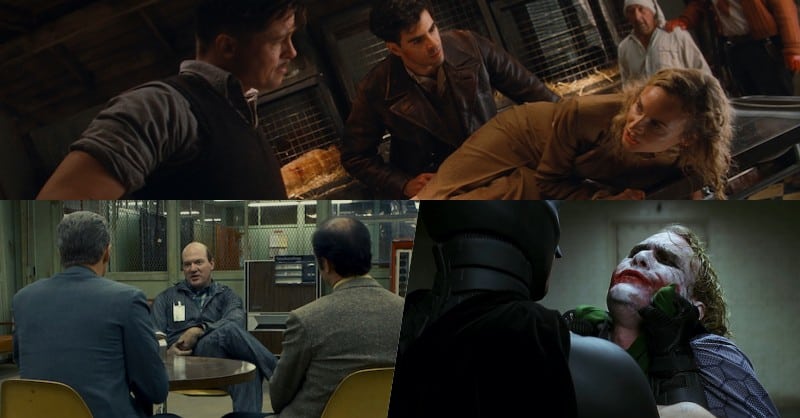Welcome to The Queue — your daily distraction of curated video content sourced from across the web. Today, we’re watching a video essay about how three directors, Quentin Tarantino, David Fincher, and Christopher Nolan, direct interrogation scenes.
If you’re a frequent reader of this column you’ll know that I’m a huge sucker for a scene breakdown. This is especially true of breakdowns that example “scene tropes,” which is to say scenes that both follow tried-and-true formulas while tweaking the rules of the expected visual language in fascinating and revealing ways.
We’ve already looked at the delicate art of the courtroom scene, dialogue-heavy scenarios founded on questions, answers, and charismatic flexing. So it only makes sense that we complete the set and take a look at the anatomy of a similar, but patently different, parallel: the interrogation scene. Much like courtroom scenes, on-screen interrogations are all about power. And like courtroom scenes, interrogation scenes follow certain patterns that can tell us a lot about what their respective director wants us to take away.
As the following video essay suggests there are (at least) three types of cinematic interrogation scenes. There are scenes that involve the transferring of power from one party to another. There are scenes that balance power between the interrogator and the interrogated, keeping things ambiguous and allowing audiences to decide for themselves where the power truly lies. And finally, there are scenes that subvert power, where blocking and staging don’t always cohere with which character actually controls the scene.
The essay provides three examples from popular culture for each type of interrogation scene: (1) the scene in Quentin Tarantino’s Inglorious Basterds where Lieutenant Aldo Raine and company question the wounded Bridget Von Hammersmark, a German spy for the Allies; (2) the scene in David Fincher’s Zodiac where the fuzz questions suspected serial killer Arthur Leigh Allen and finally (3) the chaotic and ultra-violent interrogation between Batman and Joker in Christopher Nolan’s The Dark Knight.
Examining how each director conveys dynamics of power, these scene studies are a wonderful way to further appreciate the power of visual storytelling.
Watch “The Interrogation Scene — How Tarantino, Fincher and Nolan Direct Power Dynamics”:
Who made this?
This video essay about interrogation scenes was created by StudioBinder, a production management software creator that also happens to produce wildly informative video essays. They tend to focus on the mechanics of filmmaking itself, from staging to pitches and directorial techniques. You can check out their YouTube account here.
More videos like this
- Here’s another great breakdown from StudioBinder, on the different ways film editors approach scene transitions.
- And here’s a scene breakdown from StudioBinder, on the iconic ending of The Graduate.
- Here’s more of StudioBinder’s work: a video essay that clarifies the importance of a script breakdown with a look at Wes Anderson‘s The Grand Budapest Hotel.
- And here’s StudioBinder’s video essay on what makes the business card scene in Mary Haron‘s American Psycho so effective.
- Finally, here’s their breakdown of the “expectations vs. reality” scene from the movie (500) Days of Summer.

